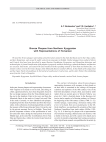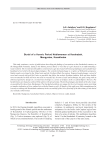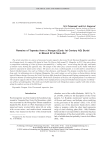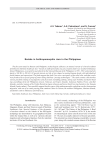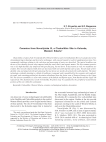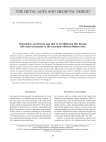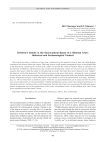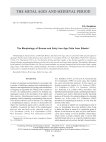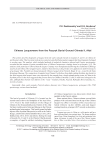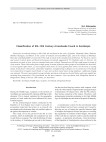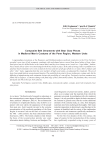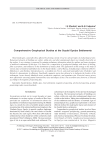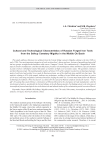The metal ages and medieval period. Рубрика в журнале - Archaeology, Ethnology & Anthropology of Eurasia
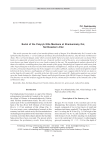
Burial of the Pazyryk elite members at Khankarinsky dol, Northwestern Altai
Статья научная
This article presents the results of an interdisciplinary study of kurgan 30 at Khankarinsky Dol, located on the left bank of the Inya River, 1–1.5 km southeast of Chineta, Krasnoshchekovsky District, Altai Territory (northwestern Altai). This is a Pazyryk kurgan, under which a looted double burial of a male and an adolescent was found. Their heads were apparently oriented toward the east. Along the northern wall of the grave, an accompanying burial of seven horses was found, placed in two rows, heads oriented to the east. The morphological analysis showed all of them to be stallions, resembling those from other mounds of this group. Morphological comparison with horses from other Pazyryk kurgans in the Altai revealed both similarities and differences. Analysis of the grave goods, including iron bits, a bone pipe-shaped bead, tiny bronze daggers in wooden scabbards, a pickaxe, numerous fragments of gold foil from the horse harness, and fragments of Chinese wooden lacquer ware, suggests that the burial was made no earlier than the 4th century BC – possibly in the late 4th to early 3rd century BC. Radiocarbon analysis was carried out at the Tomsk Institute for Monitoring Climatic and Ecological Systems of the SB RAS Center for Isotopic Studies. The funerary rite and the artifacts suggest that kurgan 30 was constructed for members of the nomadic elite of the northwestern Altai.
Бесплатно
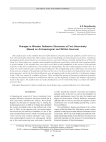
Статья научная
This study focuses on the southern line of wooden defensive structures (palisade, platform, and two towers) at Fort Umrevinsky (first third of the 18th century), based on the findings of archaeological excavations. Continuous development in this borderline fort are reconstructed over a period of 30 years. Initially, during the era of Peter the Great, Fort Umrevinsky was a regular, subrectangular fortification, enclosed by a palisade, and somewhat similar to a field redoubt. A few decades later, two towers were built on pile foundations at the corners of the palisade enclosure on the fort’s southern face. One of them was subquadratic, the other subrectangular in plan view. As a result, Fort Umrevinsky became a bastion-type fortification. The strengthening of the southern face was motivated by the presence of gates in the palisade wall between the towers, by the proximity of transportation routes (roads and waterways), and by the fact that fortifications were arranged parallel to the borderline. Fortification changes in the 1730s were caused by a number of factors. These included the spread of European fortification principles to Siberia, the political situation in southwestern Siberia, and the beginning of large-scale military engineering works in the region. The southern line of wooden fortifications at Fort Umrevinsky helps to estimate the number of towers there.
Бесплатно
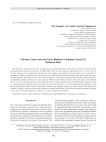
Chinese coins from the early medieval cemetery Gorny-10, Northern Altai
Статья научная
We describe a representative series of Chinese coins found during the excavations at Gorny-10, carried out by expeditions from Altai State University in 2000–2003. The coins were found in eight burials (No. 6, 18, 44–46, 48, 62, 66). Because of its composition and diversity, the sample is unusual for North and Inner Asia. It includes 29 specimens, relating to various groups. Apart from coins of the Wǔ-zhū and Kāi-yuán Tōng-bǎo types, which are rather common outside China, there are very rare ones belonging to the Cháng-píng Wǔ-zhū and Wǔ-xíng Dà-bù categories. A numismatic analysis allowed us to date separate burials and the entire cemetery. The lower date of most burials (No. 6, 45, 46, 48, 62, 66) cannot be earlier than AD 581, as evidenced by Sui coins of the Wǔ-zhū type. Burials 18 and 41, where Kāi-yuán Tōng-bǎo coins were found, are later than the 630s. In view of additional data (absence of late issues of Kāi-yuán Tōng-bǎo coins, and results of radiocarbon analysis), burials at Gorny-10 date to late 6th and 7th centuries. Notably, coins were found only in burials of women and children. Their locations suggest that they had been used as head ornaments and parts of belt sets, as well as pendants and amulets.
Бесплатно

Статья научная
This study attempts to elaborate a chronology of rock art in the Russian and Mongolian part of the Altai Mountains, from the Paleolithic to the Late Middle Ages. We focus on the style and themes of rock art and on petroglyphic palimpsests. The earliest representations date to the Upper Paleolithic. On certain palimpsests, images of horses in the Kalguty style are overlaid by Bronze Age petroglyphs. The key challenge is to identify Neolithic petroglyphs. Among the huge number of Bronze Age representations, some follow the traditions peculiar to the Afanasyevo and Chemurchek cultures. The key feature of the latter is so-called “Chemurchek anthropomorphs”. Bronze Age petroglyphs, representing animals, humans, weapons, wheeled vehicles, etc., are chronologically and culturally diverse and must be subdivided respectively. Early Iron Age ones require attribution to either the initial stage or to the mid-1st millennium BC. We discuss the difficulties of analyzing rock art of the Xiongnu-Sarmatian age, the expressive Turkic style, that of the early medieval rock art, and recent petroglyphs of the southern Russian Altai.
Бесплатно
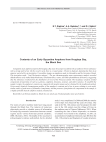
Contents of an Early Byzantine Amphora from Kruglaya Bay, the Black Sea
Статья научная
A fragment of an amphora found in the Kruglaya Bay near Sevastopol was filled with an unknown brown substance with a strong smell of tar. On the vessel’s neck, there is a round stamp ~30 mm in diameter, depicting the bust of an emperor encircled by an inscription. It resembles stamps on amphorae made in Alexandria and the Geronisos Island. The inscription reads, “επί Πτολεμαίου επάρχου”. The gas chromatography–mass spectrometry analysis revealed dehydroabietic acid, methyl dehydroabietate, norabietatrienes, retene, and other phenanthrene derivatives, suggesting that the substance resulted from dry distillation of wood of the Pinaceae family. The headspace analysis yielded components of turpentine oil such as α-pinene, camphene, limonene, cymenes, and others terpenes. To establish the sample’s origin, the amphora’s content was compared with modern pinewood tar obtained by the traditional method. Given nearly identical chromatogram profiles of the amphora’s contents and of tar in areas relating to resin acids, similar values of peak areas of biomarker components, and the presence of turpentine oil components in the sample, it is highly probable that the amphora indeed contained tar.
Бесплатно
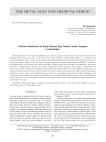
Cultural attribution of Early Bronze Age tombs under kurgans in Azerbaijan
Статья обзорная
Бесплатно
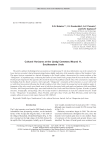
Cultural horizons at the Uyelgi cemetery mound 11, southeastern Urals
Статья научная
The article outlines the findings from excavations at Uyelgi mound 11, the most informative one at the cemetery. Its lower horizon revealed a burial demonstrating features highly indicative of the nomadic culture of the Southern Urals. The upper horizon contained two burials belonging to the Srostki culture, characterized by certain artifacts of the "Hungarian" (Carpathian) type, evidencing the return of some South Uralic groups from the west at the time when the Srostki people migrated in the opposite direction from Eastern Kazakhstan and the Altai. This conclusion is supported by findings from the Aktobe cemetery, where typically "Hungarian" ornaments of horse harness co-occur with a belt set with floral decoration following the Srostki tradition of the Altai. Inside the mound and on the platform under it, fragments of five clay vessels were found, most of which are decorated with comb-and-cord patterns of the post-Bakal, Nevolino, and Petrogrom-Yudina type, associated with the East Uralic and West Siberian Ugrians. In terms of spatial structure, stratigraphy, and typology, then, the Uyelgi mound 11 demonstrates at least four cultural horizons: South Uralic, "Hungarian" (Carpathian), Altaic (Srostki), and Ugric (East Uralic and West Siberian), jointly mirroring complex ethnic processes in the region between 800–1000 AD.
Бесплатно

